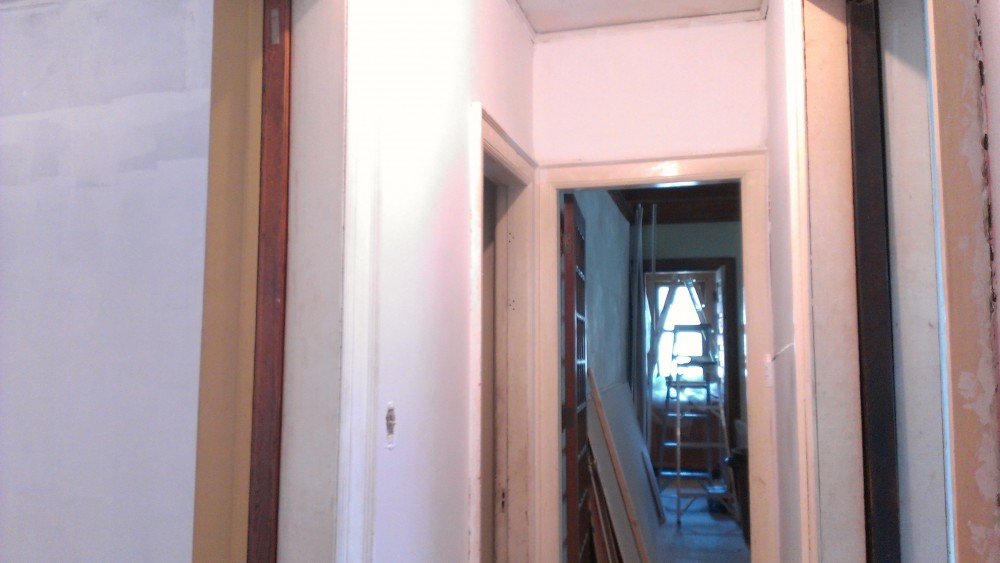For the last week or so, we’ve been sanding, prepping, spackling, and priming the front foyer and front main hallway of the house.
It took four days and nine coats of primer to turn the formerly pink plaster walls white:
It was exciting. The walls were old plaster, dyed pink from some previous wallpaper (most likely), and a bunch of us put a ton of work into patching, sanding, and priming them. It took nine coats of primer (two of PVA primer and seven of Killz) to get to these smooth white masterpieces, ready for painting.
The hallway complete, we started sanding and priming the round tower room in the front of the house yesterday. Perry and Kyle helped prime and we got one coat on the entire room.
Today Lincoln, Nicole, and I returned to continue priming. I poured the primer and got ready to apply a second coat to the foyer.
That’s when I noticed the blister.
I touched it with a scraper and it came off like latex skin. I began to horrifyingly peel back an increasingly larger sheet of latex and it just kept coming. With dread, I realized that none of the primer was sticking to the wall at all.
I called Lincoln over and showed him. He asked the question that was in my heart but that I didn’t have the courage to put voice to: is it happening in the hallway too?
This should answer that question:
After talking with our contractor and doing some thinking, we all came to the conclusion that water-based primer was the wrong primer for these walls. The plaster just drinks water, dehydrating the primer too quickly, leaving a sheet of latex just vaguely attached to dry plaster. There was no adhesion.
Lincoln, Nicole, and I dejectedly spent the next hour scraping and peeling days’ worth of work off the walls. We are set back days, especially considering that with the primer came most of the spackle that made the walls smooth.
We have to scrape, spackle, sand, and re-prime (using oil-based primer this time) the entire hallway and foyer. It’s like starting over again. Forget how much money in primer and spackle we’ve wasted (it’s a lot). The more depressing figure is the amount of time that we’ve wasted.
We need a lot of help, labor-wise. We desperately need people to come out and help us scrape, peel, spackle, and sand. Again.
It was a bad day.



Stacy and I have crazy schedules right now, but please - keep us updated about your plans, and if we can find some time when we're both on the east side of MI, we're easily bribed with beer and pizza.
Do not let this get you down, think of using white paint over old-style Kilz-- which will allow latex paint over it. That will save on paint until you later have money for lots of color, capisce?
I did not research this on the web, it is from learning from an old Damman Hardware employee about an alkali problem possible in old plaster. He had worked at the Detroit Damman store on Hayes (I think that was Detroit). HE taught me to sell Kilz or BIN (Zinnser brand, shellac based paint primer) where there was a need to handle chemical reaction bubbles in latex based primer. Process he taught me was peel off offending bubbled primer, seal with Kilz, (preferred), then paint with choice of paint. He was in his late 70's 25 years ago, but he knew old construction.
Another surer way out of this mess-- see what it would cost to drywall the hallway, then use Kilz II on the drywall. Might prove cheaper for 10-15 years or so and get you past move-in inspection faster also than doing all that labor(not getting into that any more here, just a mention).
Lincoln, check your PayPal, will send some extra money this month (tonight).